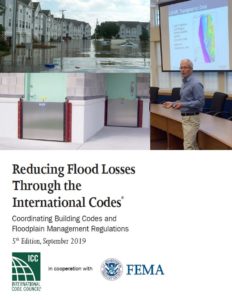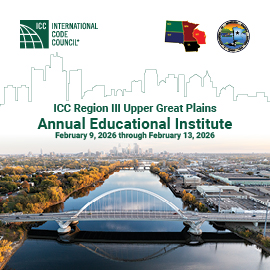
Reducing flood losses through the International Codes
 Continuously shaped by the forces of water, either through erosion or the buildup and the deposit of sediment, floodplain landscapes continue to be altered by human development. The most common and costly natural disaster, flooding events cost an estimated $126.2 billion between 1980 and 2019 in the U.S. alone, according to the National Oceanic and Atmospheric Administration’s National Centers for Environmental Information. The adoption of higher floodplain management standards integrated with leading building safety codes will lead to safer, stronger, more resilient communities.
Continuously shaped by the forces of water, either through erosion or the buildup and the deposit of sediment, floodplain landscapes continue to be altered by human development. The most common and costly natural disaster, flooding events cost an estimated $126.2 billion between 1980 and 2019 in the U.S. alone, according to the National Oceanic and Atmospheric Administration’s National Centers for Environmental Information. The adoption of higher floodplain management standards integrated with leading building safety codes will lead to safer, stronger, more resilient communities.
The International Codes, a family of building codes developed and maintained by the International Code Council, shares common goals with the National Flood Insurance Program (NFIP): protection of public safety and reduced property damage. The benefits of coordinating building codes and floodplain management regulations include reduced duplication and conflict between requirements and improved, consistent, and thorough review, permitting, and enforcement processes.
Reducing Flood Losses through the International Codes was developed by the International Code Council and the Federal Emergency Management Agency (FEMA) to help state and local officials integrate the International Codes into their current floodplain management regulatory processes related to structures, buildings and other development in special flood hazard areas in order to satisfy the requirements to participate in the NFIP. FEMA considers hazard resilience to start with building codes and urges adoption and use of the latest published editions of the International Codes for buildings and structures.
“With 90 percent of all presidentially declared natural disasters in the United States involving flooding, the International Codes ensure buildings are properly constructed to prevent against the worst of flood damage,” said Code Council Executive Officer Dominic Sims, CBO. “We are pleased to partner with FEMA to share this valuable information to aid in the successful integration of the International Codes into the current floodplain management regulatory processes of state and local jurisdictions.”
Did you know?
- Between 1980 and 2019, flooding events caused an estimated $126.2 billion in the U.S.
- Flooding disasters carry an average cost of $4.3 billion per event.
- Ninety percent of all presidential declarations of emergency and major disasters involve flooding.
- Direct and indirect costs of flood recovery are borne by all U.S. taxpayers, not just flood victims.
- About 200 Americans lose their lives in floods each year.
- Flooding events are ranked in the top five extreme weather events that take the most human lives, ranking alongside tornadoes, hurricanes and lightning.
Careful attention is required to ensure that all requirements of the NFIP are addressed through a combination of building codes and other regulations. Senior Staff Architect Kimberly Paarlberg with the Code Council’s Technical Services division and members of the Code Council’s Government Relations department provided updates to the document. The new edition and its accompanying model code-coordinated ordinances contain updated and new content based on the 2018 International Codes and is organized as follows:
- Chapter 2 describes three approaches for coordinating the International Codes and local floodplain management regulations and identifies a number of advantages and considerations when relying on the flood provisions of the codes.
- Chapter 3 explains several differences between the NFIP regulations and the International Codes requirements related to specific terminology and provisions. Many requirements in the codes are more restrictive than the NFIP requirements, and some provisions are more specific.
- Chapter 4 contains a series of questions that states and communities should consider and answer to know whether and how to modify existing floodplain management regulations to coordinate with building codes.
- Chapter 5 describes modifications that can be adopted to incorporate higher standards in state and local building codes that are based on the International Codes to further increase building and community resilience to flooding damage.
- Chapter 6 introduces the model code-coordinated ordinances prepared by FEMA.
- Appendix A lists cited references and other resources that are useful for understanding and interpreting the requirements of the NFIP.
- Appendix B provides sample checklists for a plan review and inspection.
This guide may also be useful to state and local officials when applying the flood provisions of the International Codes to mitigation and recovery projects approved for FEMA grant funding. It is not intended as an endorsement of any specific approach for effectively managing flood hazards, nor does it explain all of the NFIP and building code requirements and how to administer them. FEMA and others have produced numerous documents and publications related to the NFIP and the regulation of flood hazard areas.







